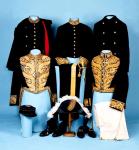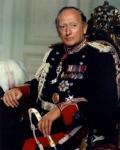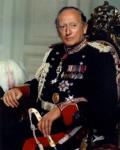
James Hoard
For Deletion-
Posts
632 -
Joined
-
Last visited
-
Days Won
1
Content Type
Profiles
Forums
Blogs
Gallery
Events
Store
Everything posted by James Hoard
-
American War of Independence....
James Hoard replied to mariner's topic in Great Britain: Research, Documentation & History
I doubt it. If the American Revolution never happened, France would not have gone bankrupt and had their revolution, so ultimately no need for a Boney to sell Louisiana. Expansion eastwards would have been severely limited. -
American War of Independence....
James Hoard replied to mariner's topic in Great Britain: Research, Documentation & History
Well, if they were "Englishmen" the RWF would never have refused! -
Sushil, Jath was a non salute state. Please see http://www.royalark.net/India2/jath.htm The rulers were sans title until 1935. They had originally been Desmukhs of Bijapur and made themselves independent when it fell in 1686. The holder, who had been a military Sardar, then joined the Mughals and was made a mansabdar and was recognised as an Imperial vassal. In 1819 the Desmukh was recognised as a British guaranteed jagirdar under the Raja of Satara. They then became direct tributaries in 1839. The title of Raja was conferred as a hereditary distinction, on the gentleman whose picture I posted, in 1935. He only left daughters, so had no immediate successor. There was a certain Captain Rajindra Sinh Vijay Sinh Dafle, of the 1st Mahratta Light Infantry, who served in the Indo-Pak War of 1971 and was awarded the Vr.C. He may or may not have been Raja' Vijaysinhrao's adopted son. The Raja merged his state into Bombay in March 1948, so could have instituted his own medals in the period between August 1947 and March 1948. There was nobody to stop him during that time. Cheers, James
-
Indeed that is the interesting question. But I guess that identifications having surfaced so far, our resident expert may not actually know themselves. Perhaps these were medals instituted by the Raja of Jath himself. During the brief 'Indian Summer' between Independence on the 15th of August 1947 and actual merging of the states into India or Pakistan between 1940 and 1950, several rulers went to town instituting orders and decorations. May be he was one of them. An interesting mystery. Cheers, James
-
I have done a little bit of googling and found these two articles with some pictures. They are small, so not very helpful, though one can establish the following. http://www.bbs.com.bt/HM%20grants%20Druk%2...%20Wangyel.html The above features several recipients of the Druk Thuksey. From this we can conclude that the picture posted earlier by fjcp is in fact the Druk Thuksey. http://www.bbs.com.bt/His%20Majesty%20awar...f%20Bhutan.html The above features a picture of the two recipients of the Druk Wangyel. The design of the insignia is quite different from the Druk Thuksey, so we can conclude that they are indeed separate awards. The Druk Wangyel insignia seems to consist of a badge worn from an orange neck ribbon with gold edges with, apparently, a star worn on the breast but unusually suspended from a medal ribbon of the same colour, orange with gold edges. I seem to remember that there was some old Turkish Ottoman order that was worn in a similar fashion. Cheers, James
-
I am happy to defer to superior knowledge. What I did was magnify and brighten the picture but the only conlcusion I could draw was that the ribbon still looked dark, very slightly lighter than the War Medal ribbon. I then looked up the Medal Year Book and the only other possible star seemed to be the Pacific Star, with a largely green centre, which probably would appear lighter than the red of the War Medal in a b/w photo. What are the three medals and from which princely states? Cheers, James
-
Thanks for the link, but I am not very certain what the picture is actually of. If one looks at the article, the picture is labelled as "Druk Thuksey". However, look at the URL for the actual picture shown and it says "drukwangyel". Indeed, the picture is placed next to a paragraph about awards of the Druk Wangyel. However, the ribbon and design are almost identical to what is usually called the Royal Order of Bhutan. Give or take the usual design modifications for a lower class of the order. Of course, it is always possible that "Druk Wangyel" (which translates as 'Great Victory of the Thunder Dragon') is the name in Bhutanese for what is called the "Royal Order of Bhutan" in English. The final possibility is that both "Druk Wangyel" (which translates as Great Victory of the Thunder Dragon)and "Druk Thuksey" (which translates as 'Son of the Heart of the Thunder Dragon') are different classes of the same decoration, which Westerners have come to call "The Royal Order of Bhutan". As a general observation I have noticed that members of OMSA frequently label any order that happens to come from a foreign kingdom and whose name they do not know as "the Royal Order of (name of country)". Cheers, James
-
The second class set on the right belonged to his nephew, The Rt Hon Sir Felix Cassel, Bart, KC, sometime Judge Advocate General. ? Christie's 2008 The first lot consisted of Sir Ernest Cassel's First Class Full Dress Civil Uniform, First Class Levee Dress Civil Uniform, Cloak and the "Russian" pill-box style cap (not B ritish) went for US$2,940. The second lot consisted of the rest: Sir Felix Cassels Second Class Full Dress Civil Uniform, white breeches and court shoes with gilt buckles; First Class Lev?e Dress coatee and trousers; sword with gilt hilt, gold lace sword-knot with bullion tassel complete with chamois leather slip and black oil-skin outer cover; bicorne hat; double breasted great coat, Wellington boots, shirts, collars and other sundry items all sold for US$ 4,900. Cheers, James
-
Sushil, I do not follow what you mean by three medals before the Independence Medal. The Independence Medal seems to be the first in the group. The ones I do not know about are the second, third and fourth (i.e. between the Independence Medal and 39/45 Star). I said Pacific Star because it was the usual award for the Navy for Service in the Indian Ocean, Pacific or South China Sea. The Burma Star was restricted to operational service in Burma waters and Eastern Bay of Bengal. Though I gather that they were also been awarded for service off the Coasts of Sumatra. Yours etc James
-
I found this interesting picture showing early twentieth century examples of full sets of both the First and Second Class Civil Uniforms in both full dress and levee versions. Sold at Spinks in 2000 the first class set of the left belonged to The Rt Hon Sir Ernest Cassel, GCB, GCMG, the great financier and grandfather of Lady Edwina Mountbatten. The second class set on the right belonged to his nephew, The Rt Hon Sir Felix Cassel, Bart, KC, sometime Judge Advocate General. ? Christie's 2008 Cheers, James
-
Hi, Does anyone know if there are any online resources for searching details on those buried at Arlington National Cemetary in Washington? I am trying to find details on a Major Murad (Harry) Baig and his family, who were all killed in a fire at the Imperial Hotel in Bangkok in 1971. They were supposedly all buried in a single grave at Arlington. Baig had been an intelligence officer in Vietnam and then served as an intelligence adviser to the Thai Army. He had an interesting background. His father was the Pakistani Foreign Secretary and he was educated at Clifton in Bristol, England, a school noted for preparing people for Sandhurst. He decided to enlist in the US Marines instead, then earned a commission a few years later and had a very distinguished couple of tours in Vietnam. His wife was the daughter of Count Nicholas de Rochefort, a Russian emigre who worked for the CIA and Voice of America for many years. Thanks, James
-
I am not surre how you make that out. The collar and cuffs for the third to the fifth class are given on page 38 with colour illustrations between pp 38-39 in the bboklet http://www.archive.org/stream/dressinsigniawor00greauoft As far as I can tell it seems to be the Civil Uniform 2nd Class Levee Dress. Cheers James
-
Thanks a million Lawrence, that is a great help. I have since learned that this is the last Raja of Jath, Lieutenant-Commander Raja Vijaysinhrao Ramrao Raje Dafle, Raja of Jath. Born 21st July 1909. 14th August 1928. Succeeded Died, 12th July 1998. He was Cmsnd as Hon Sub-Lieut RIN 27/6/1934, prom Hon Lieut 27/6/1937, served in WW2 1940 ? 1944 (no details found), and prom Hon Lieut-Cdr 27/6/1945. Could the third last medal be a Delhi Durbar silver medal from 1911? He would have been Heir Apparent and aged two years and six months at that time. Did they receive the medal whatever their age, as did later Heirs Apparent the George VI Coronation Medal in 1937. One of the latter recipients was so young he was still unnamed! Cheers, James
-
Unfortunately, I have posted the largest that I have. I can only suggest that if you have a zoom facility on your page settings to try and use that to magnify the picture. My particular interest was drawn by the second, third and fourth medals. The first appears to be the Indian Independence Medal. The fifth would be the 39/45 star, the next probably Pacific Star, War Medal follwoed by India Service. Then another mystery before the Silver Jubilee and Coron 1937 Medals. Cheers, James
-
Can someone please be kind enough to identify the medals being worn by this Indian Naval officer from the later 1950's. Cheers, James
-
Medals of Papua New Guinea
James Hoard replied to Lukasz Gaszewski's topic in South East & East Asia
Is that actually true or is it another urban myth generated by the dreaded "wikipedia"? As far as I can tell, the PM's style is "Grand Chief Rt Hon Sir Michael Somare, GCL, GCMG, CH, CF, KStJ". The Governor-General is similarly styled "H.E. Grand Chief Sir Paulias Matane, GCL, GCMG, OBE, KStJ" At least that was how he was officially styled at the King of Tonga's coronation in 2008. Indeed, I would be quite surprised to see otherwise, since Somare took such great pains NOT to follow the Australian methods in all this and kick dust in the face of the Brits. British awards have been retained for the Queen's Birthday awards, the Princess Royal was invited to preside at the first new indigeneous awards ceremony, she and her husband were appointed to two of the orders, and later the Prince of Wales and Duke of Edinburgh also received appointments in the senior grade. Cheers, James -
The booklet that I gave is dated 1921 and therefore takes into account the relaxation of rules brought on by the Great War 1914-1918. By then the cost of the Full Dress First Class Civil Uniform had meant that it was getting out of the reach of some "poor" Privy Councillors. Remember that most government ministers have to be sworn of the Privy Council, and by the time of the Great War a good number of them no longer came from the traditional landed or moneyed classes. Although they could rent the uniforms from Moss Bros, they still cost the earth. Hence the relaxation in allowing the Levee Dress version to be used on state occasions. Governors and Governor Generals had their own uniform, which they wore if they did not hold the rank of Rear Admiral or equivalent and higher. That uniform is illustrated a few pages down. The hat is magnificent, a layer of red goose feathers eminating from the top, covered by a layer of pure white feathers over the red. A slight breeze produces a marvelous effect. One sometimes sees the Full Dress uniform worn by some Canadian Lieutenant-Governors even today, since Lieutenant-Governors are entitled to the Second Class Civil Uniform. It is similiar to the First Class but with slightly less gold embroidery (four inches to the cuff instead of five, etc). Though, for some odd reason ever since a member of the Canadian Monarchist League wrote some rot about it being the "Windsor Uniform" and "especially approved for Canadian LGs in the 1930's", people have started calling it that up north, even on official government websites. Entirely incorrect s incethe Windsor Uniform, also described in the booklet, is a very different animal. As far as the UK is concerned, nowadays we tend to only see the Civil Uniforms worn by members of the diplomatic service. Normally the Under Secretary of State for Foreign Affairs or the Marshal of the Diplomatic Corps (if not a military gent) will be seen wearing them when a new foreign Ambassador is presenting his credentials to HM. British Ambassadors to foreign countries, usually to those monarchies that still hold the old fashioned "stiff" formal gala or court ceremonies (e.g. Thailand or Denmark), attend wearing the civil uniform. Here's a link to a recent picture of the Marshal of the Diplomatic Corps in London, Sir Anthony Figgs, with the Rumanian Ambassador after the latter presented his credentials to the Queen http://londra.mae.ro/images/images_stiri/l...08_05_02(3).jpg Cheers, James
-
TS, As a Privy Councillor he is as high as the highest ranking Ambassadors, who would have usually been made Privy Councillors themselves. What you have purchased is actually the First Class Civil Uniform - Levee Dress. The Full Dress version is much grander, with the whole breast covered in gold thread embroidery of oak leaves and the like in a sort of "V" shape from the shoulders to the waist. The latter was worn with white knee breeches, white silk hose and pumps. You may like to go through the booklet called "Dress and Insignia Worn at His Majesty's Court" (1921). Here is a link to an online version, you can turn the pages and look at the descriptions and illustrations in colour (after wading through a host of adverts): http://www.archive.org/stream/dressinsigniawor00greauoft Hope the link works! Cheers, James
-
Hello TS, A lovely find. To be a little more precise, there is no such thing as a "diplomatic uniform". These are civil court uniforms. Although diplomats were entitled to wear them according to whatever their particular rank according to the table of precedence, so were civil servants and other civil officials such as governors, lieutenant-governors, administrators, privy councillors and the like. In this case your man is The Rt Hon Stephen Woulfe Flanagan, who was in 1877 a Member of HM's Privy Council in Ireland and Judge of the Landed Estates Court. He was sworn of the Privy Council of Great Britain on 12th December 1885. Source: London Gazette online. Cheers, James
-
American War of Independence....
James Hoard replied to mariner's topic in Great Britain: Research, Documentation & History
I don't know about the "under God" part, but the Nazi salute's give me a good many more shivers! Cheers, James -
American War of Independence....
James Hoard replied to mariner's topic in Great Britain: Research, Documentation & History
George III suffered from a blood desease, not from any effects of the loss of the former American colonies. He greeted John Adams, the first US Envoy sent to open diplomatic relations with Great Britain, with a warm handshake and told him "I was the last man in England to consent to the Independence of America, I will be the last in the world to sanction any violation of it." If those were the sentiments of a deranged mind, let us have more of them. Cheers, James






